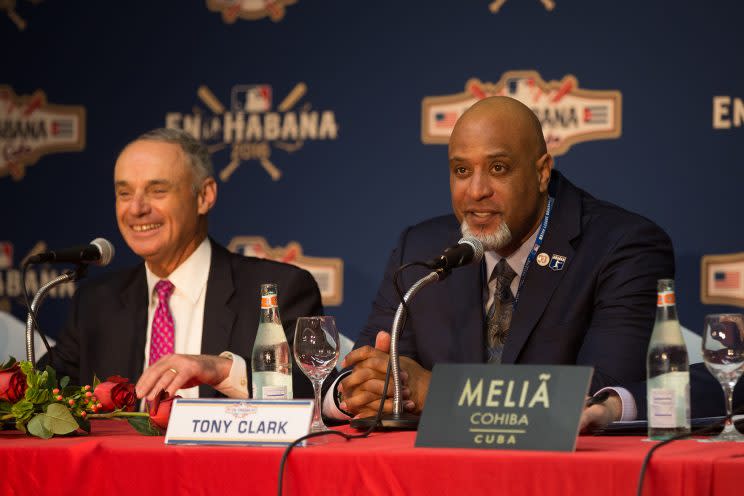Four more things you need to know about the new CBA
On Wednesday, the owners and Major League Baseball Players Association agreed to a new five-year collective bargaining agreement with hours to spare before the old agreement ran out and possible chaos ensued.
We already brought you up to speed on some of the more interesting details that were initially made public. Now though, we’ve learned the full outline of the deal, which has helped to fill in many of the blanks that were left open to interpretation and speculation for roughly 48 hours.
It’s also opened our eyes to some other interesting changes set to be implemented that will no doubt have a major impact on the game between now and 2021.
Right here, we’ll take a look at four additional changes that are creating some buzz and are worth discussing.

DRUG TESTING WILL BE INCREASED
Under the new CBA, the number of in-season random urine test will increase from 3,200 to 4,800, while the number of offseason random tests will increase from 350 to 1,550. Those additional tests were put in to ensure that all 40-man roster players will be subject to at least one random off-season test.
The additional testing sends a clear and consistent message that MLB is taking its drug-testing policy seriously. It should also help ensure that players won’t experiment during the offseason and end up slipping through the cracks knowing that a random drug test was less likely than it is now.
Here are some changes in baseball's CBA that relate to drug testing. Short version: More tests. pic.twitter.com/SJwEFFNcG8
— Big League Stew (@bigleaguestew) December 2, 2016
AN ANTI-HAZING AND ANTI-BULLYING POLICY IS COMING
This development comes on the heels of the hazing scandal in the Texas Rangers organization that resulted in eight prospects being questioned by police in the Dominican Republic after a video showed a group of players sexually assaulting an underage teammate. There were no further details released here, but this would seem to be a step forward in spotlighting the issue and hopefully changing the hazing culture in the future.
No, not all hazing incidents are as troubling as the one involving the Rangers. Some, such as rookies being forced to dress up in costumes for road trips, come across as harmless. For the most part they are, but if it means eliminating those to help change the idea that hazing and bullying new players is OK, then it’s worth it.

MORE CHANGES TO ALL-STAR GAME
We’ve already learned the All-Star game will no longer determine home-field advantage in the World Series. We now also know that a money bonus will be dangled over the players as incentive.
The winners of the All-Star Game will split $640,000 in bonus money this year. Guarantee that has a bigger impact than home field ever did.
— Jeff Passan (@JeffPassan) December 2, 2016
With 32 players on each All-Star roster, it comes out to $20,000 for each player. It’s a drop in the bucket for most of the players involved, but money is still a nice motivator. Here’s hoping some of that money will end up going to charities or organizations that need it far more than baseball’s best.
One more All-Star note. No longer will the respective league managers be in charge of picking the final players on each roster. That responsibility now belongs to the commissioner’s office.
TEAM MUST ADD BILINGUAL MEDIA RELATIONS PERSONNEL
In a provision that’s long overdue, the parties agreed to require all 30 teams to retain a bilingual media relations professional, while providing additional English Language learning opportunities for Spanish-speaking players.
Honestly, it’s a little surprising MLB hasn’t been more ahead of the curve in this regard considering how global the game has become. It’s better late than never though, and we’re hopeful it will get teams more focused on this matter moving forward.
More MLB coverage from Yahoo Sports:
– – – – – – –
Mark Townsend is a writer for Big League Stew on Yahoo Sports. Have a tip? Email him at bigleaguestew@yahoo.com or follow him on Twitter!

 Yahoo Sports
Yahoo Sports 

